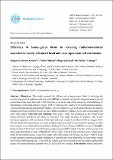| dc.description.abstract | This study assessed the efficacy of a honey–grape blend in reducing the
severity and onset of radiation oral mucositis (ROM) in patients with locally advanced squamous cell
carcinoma of the head and neck. Oral mucositis is an acute side effect caused by chemotherapy or
radiotherapy in the head and neck region. ROM affects patients’ quality of life and treatment expenses.
Various pharmaceutical and natural remedies, such as sucralfate, aloe vera, and amifostine are used to
mitigate the effects of ROM. However, the available modalities’ efficacy is low and is associated with
many side effects. Materials and methods: This cohort study was conducted at the Ocean Road
Cancer Institute and Besta Polyclinic in Tanzania. The study included 73 patients with locally
advanced squamous cell carcinoma of the head and neck treated from March 2024 to August 2024.
The World Health Organization mucositis grading system was used to assess patients’ progress weekly.
Data analysis was conducted using Statistical Package for Social Science (SPSS) version 27. Results:
Delayed onset (15% Grade 3 for the honey–grape group and 45% Grade 3 for the control group at 28
days) and reduced the severity of ROM (only 20% Grade 3 with no Grade 4 for the honey–grape group
while for the control group, it was 25% Grade 3 and 20% Grade 4 at 45 days) (p-value < 0.001). Body
weight changes at starting and after completion of radiotherapy were observed (2.65 kg average weight
loss for the control group and 1.8 kg, 0.45 kg weight gain for the honey group and honey–grape blend
group). Prevalence between genders was 62% males and 38% females. Conclusions: Honey and honey
91
blended with grapes can minimize the severity and delay the onset of ROM in patients with locally
advanced head and neck cancer. More studies are needed, since no study has been conducted
addressing the efficacy of honey–grape blends in reducing ROM severity. | en_US |

